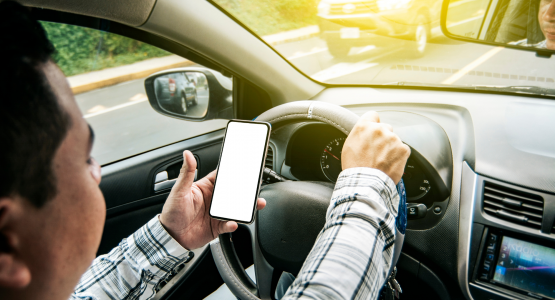Distracted driving has become a growing problem on the roads, with behavior that goes far beyond texting and talking on a cell phone. The Centers for Disease Control and Prevention (CDC) identifies three primary types of distractions: visual distractions that take your eyes off the road, manual distractions that remove your hands from the wheel, and cognitive distractions that divert your mind from driving. Each type can lead to dangerous situations, with texting while driving increasing the risk of a crash by 23 times compared to driving without distractions.
Recent data from the 2024 Travelers Risk Index on Distracted Driving show that distracted driving behaviors are on the rise, with activities like updating or checking social media, typing a text or email, and talking on a cell phone (even hands-free) increasing significantly since before the pandemic. Additionally, nearly half of respondents believe that roads are less safe than a year ago, while 78% agree that inattentive driving is more of a problem now than in previous years. This troubling trend aligns with official reports from the National Highway Traffic Safety Administration (NHTSA), indicating a 10.5% increase in U.S. traffic deaths in 2021.
Addressing Distracted Driving in Business and Beyond
Employers are increasingly concerned about distracted driving among their employees. The 2024 Travelers Risk Index revealed that 85% of surveyed executives are worried about employees using mobile technology while driving, compared to 77% in the previous year. This concern persists despite 68% of businesses implementing distracted driving policies, which often include prohibiting the use of handheld devices while driving, requiring employees to sign acknowledgments of the policy, and disciplining those who violate the rules.
To tackle the issue of distracted driving, the Travelers Risk Index suggests several measures that can motivate drivers to remain focused. Passenger intervention and financial rewards for safe driving are two of the most effective strategies. Technology also offers solutions, with driver monitoring systems (DMS) using cameras and sensors to detect signs of distraction or drowsiness, and smartphone apps that disable distracting features while the car is in motion. Education and awareness campaigns are crucial for changing driver behavior and reducing the prevalence of distracted driving on our roads.
As technology evolves, so must our strategies for combating distracted driving. By adopting a proactive approach, we can ensure safer roadways for everyone and reduce the tragic consequences of distracted driving. If you have questions or need guidance on this topic, contact OIA at (800) 555-1742 for the latest information on state laws and best practices for addressing distracted driving.
Legal Disclaimer: This material is intended to provide general background and insight but does not constitute legal advice. For specific analysis and advice, please consult legal counsel. Laws and rules are subject to change. Always ensure compliance with state law by consulting your attorney, banker, or CPA. If you have further questions, contact OIA for additional guidance.
Cited Resources
Distracted Driving Statistics & Facts in 2024
Christy Bieber, JD Contributor
Brette Sember, JD Contributor
Updated: Feb 23, 2023, 5:02am
https://www.forbes.com/advisor/legal/auto-accident/distracted-driving-statistics/
National Highway Traffic Safety Station (NHTSA) Report.
2024 Travelers Risk Index on Distracted Driving
April 11th, 2024
2024 Travelers Risk Index on Distracted Driving
https://www.travelers.com/resources/auto/distracted-driving/what-is-distracted-driving


